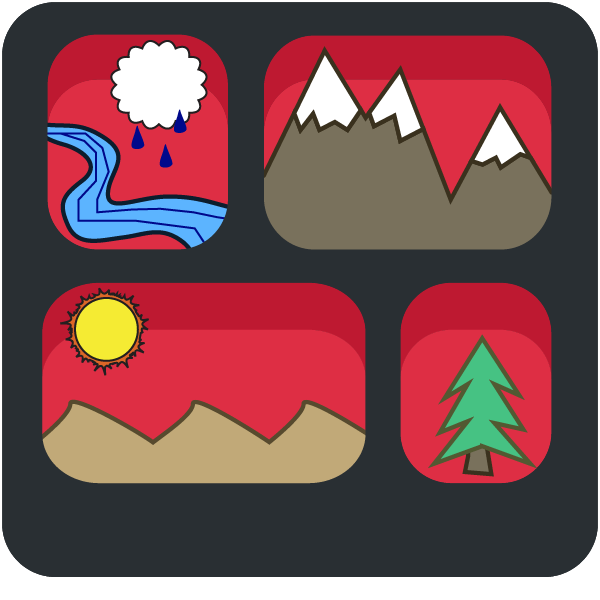-
class
BasicRtVs¶
Model BasicRtVs¶
terrainbento BasicRtVs model program.
Erosion model program using linear diffusion, stream power with spatiall varying erodibility based on two bedrock units, and discharge proportional to effective drainage area.
- Landlab components used:
-
class
BasicRtVs(clock, grid, hydraulic_conductivity=0.1, **kwargs)[source]¶ Bases:
terrainbento.base_class.two_lithology_erosion_model.TwoLithologyErosionModelBasicRtVs model program.
This model program combines the
BasicRtandBasicVsprograms by allowing for two lithologies, an “upper” layer and a “lower” layer, and using discharge proportional to effective drainage area based on variable source area hydrology. Given a spatially varying contact zone elevation, \(\eta_C(x,y))\), model BasicRtVs evolves a topographic surface described by \(\eta\) with the following governing equations:\[ \begin{align}\begin{aligned}\frac{\partial \eta}{\partial t} = - K(\eta,\eta_C) A_{eff}^{m}S^{n} + D\nabla^2 \eta\\K(\eta, \eta_C ) = w K_1 + (1 - w) K_2\\w = \frac{1}{1+\exp \left( -\frac{(\eta -\eta_C )}{W_c}\right)}\\A_{eff} = A \exp \left( -\frac{-\alpha S}{A}\right)\\\alpha = \frac{K_{sat} dx }{R_m}\end{aligned}\end{align} \]where \(Q\) is the local stream discharge, \(S\) is the local slope, \(m\) and \(n\) are the discharge and slope exponent parameters, \(W_c\) is the contact-zone width, \(K_1\) and \(K_2\) are the erodabilities of the upper and lower lithologies, and \(D\) is the regolith transport parameter. \(\alpha\) is the saturation area scale used for transforming area into effective area and it is given as a function of the saturated hydraulic conductivity \(K_{sat}\), the soil thickness \(H\), the grid spacing \(dx\), and the recharge rate, \(R_m\). \(w\) is a weight used to calculate the effective erodibility \(K(\eta, \eta_C)\) based on the depth to the contact zone and the width of the contact zone.
The weight \(w\) promotes smoothness in the solution of erodibility at a given point. When the surface elevation is at the contact elevation, the erodibility is the average of \(K_1\) and \(K_2\); above and below the contact, the erodibility approaches the value of \(K_1\) and \(K_2\) at a rate related to the contact zone width. Thus, to make a very sharp transition, use a small value for the contact zone width.
Refer to Barnhart et al. (2019) Table 5 for full list of parameter symbols, names, and dimensions.
- The following at-node fields must be specified in the grid:
topographic__elevationlithology_contact__elevationsoil__depth
-
__init__(clock, grid, hydraulic_conductivity=0.1, **kwargs)[source]¶ - Parameters
clock (terrainbento Clock instance) –
grid (landlab model grid instance) – The grid must have all required fields.
m_sp (float, optional) – Drainage area exponent (\(m\)). Default is 0.5.
n_sp (float, optional) – Slope exponent (\(n\)). Default is 1.0.
water_erodibility_upper (float, optional) – Water erodibility of the upper layer (\(K_{1}\)). Default is 0.001.
water_erodibility_lower (float, optional) – Water erodibility of the upper layer (\(K_{2}\)). Default is 0.0001.
contact_zone__width (float, optional) – Thickness of the contact zone (\(W_c\)). Default is 1.
regolith_transport_parameter (float, optional) – Regolith transport efficiency (\(D\)). Default is 0.1.
hydraulic_conductivity (float, optional) – Hydraulic conductivity (\(K_{sat}\)). Default is 0.1.
**kwargs – Keyword arguments to pass to
TwoLithologyErosionModel. Importantly these arguments specify the precipitator and the runoff generator that control the generation of surface water discharge (\(Q\)).
- Returns
BasicRtVs
- Return type
model object
Examples
This is a minimal example to demonstrate how to construct an instance of model BasicRtVs. For more detailed examples, including steady-state test examples, see the terrainbento tutorials.
To begin, import the model class.
>>> from landlab import RasterModelGrid >>> from landlab.values import random, constant >>> from terrainbento import Clock, BasicRtVs >>> clock = Clock(start=0, stop=100, step=1) >>> grid = RasterModelGrid((5,5)) >>> _ = random(grid, "topographic__elevation") >>> _ = random(grid, "soil__depth") >>> _ = constant(grid, "lithology_contact__elevation", value=-10.)
Construct the model.
>>> model = BasicRtVs(clock, grid)
Running the model with
model.run()would create output, so here we will just run it one step.>>> model.run_one_step(1.) >>> model.model_time 1.0
-
run_one_step(step)[source]¶ Advance model BasicRtVs for one time-step of duration step.
The run_one_step method does the following:
Directs flow, accumulates drainage area, and calculates effective drainage area.
Assesses the location, if any, of flooded nodes where erosion should not occur.
Assesses if a
PrecipChangeris an active boundary handler and if so, uses it to modify the erodibility by water.Updates the spatially variable erodibility value based on the relative distance between the topographic surface and the lithology contact.
Calculates detachment-limited erosion by water.
Calculates topographic change by linear diffusion.
Finalizes the step using the
ErosionModelbase class function finalize__run_one_step. This function updates all boundary handlers handlers bystepand increments model time bystep.
- Parameters
step (float) – Increment of time for which the model is run.
